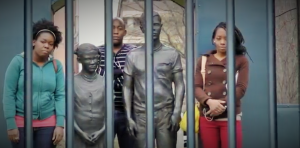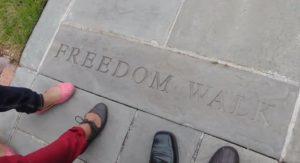A BYU class with a five-day tour of Civil Rights Movement sites helps students connect with recent history and understand expectations for the future.

The class, SFL 595R, is part of the School of Family Life and first appears to involve fairly typical elements such as reading and writing assignments. However, the participants also have the unique opportunity to attend a five-day tour of major sites from the 1960s civil rights movement in Alabama and Georgia each March.
“It was a great journey for all of us that went,” said Chase Phillips, a BYU history major who went on the civil rights trip in 2013. “Now, I feel like I’ve gained a better understanding of where I came from, my personal history and what people have done to get me to where I am today.”
Students can enroll in the class winter semester, but the group attending the trip is selected through an application process.
Rebecca de Schweinitz, history professor and accompanying faculty member on the civil rights trip, said the students really get to step back in time and come to better understand the terror African-Americans felt during those times.
The students have also gained a better appreciation for what they have now in terms of civil rights. They visit many historical sites significant in the life of Martin Luther King Jr., the Rosa Parks Museum and the Edmund Pettus Bridge. As they travel through Selma, Ala., Atlanta and Montgomery, Ala., the students get to meet people who lived there during the civil rights movement who share their personal stories.
BYU students who attended the civil rights trip have experienced rare opportunities future students may not get to replicate. Since racial segregation was abolished in 1954, people who lived through the civil rights movement may not be around much longer to continue telling their stories. However, students like Phillips seem eager to share what they learned on their trip.

Phillips received the opportunity to complete an internship in South Africa. The civil rights trip helped prepare him for an environment where he was no longer a minority.
“The people of Africa have had a difficult past; the U.S. has had a difficult past as well. But there’s hope in healing with people, events, and it is very eye-opening,” Phillips said.
“Through these trips, I have learned how to be a better Christian and a more loving and courageous advocate for truth,” said Jonathan Sandberg, an adviser for the trip and a professor in the School of Family Life.
Students on the trip last year also received some exciting news that would largely open discussions on a related sensitive subject — race and the priesthood.
Anthony Bates, adviser to the Black Student Union and one of the faculty attending the civil rights trip, said during the trip in 2013, The Church of Jesus Christ of Latter-day Saints released a new introduction to the Official Declaration 2, released in 1978. Official Declaration 2 is a document from the LDS Church officially stating it was an acceptable time for black members to hold the priesthood and participate in temple ordinances.
Bates said it was a liberating experience that opened much discussion while on their trip as well as when they returned.
The new introductory statement and the civil rights trip can help students better understand racial and cultural backgrounds.
“To me, the trip is important because it helps students understand the spirituality and strength of those good Christians who fought to bring respect, dignity and equal rights to people of color,” Sandberg said. “Each of us has a responsibility to make the world a place where people of all races can receive an education and the benefits that come when we are protected by the law of the land.”
Students have unique opportunities as they attend BYU that help them learn about their own history and culture as well as other cultures. The trip can be a beneficial experience for students to gain more appreciation for the people before them and an understanding of what is expected of them in the future.
“I think what I took from the trip the most was gratitude for the past and vision for the future,” Phillips said.




